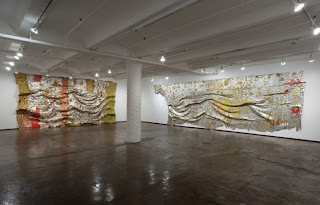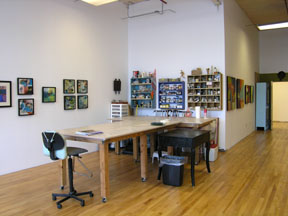Binnie and I trudged down 20th street in Chelsea with snow blowing in our faces, climbed huge snow piles and picked our way through deep puddles of slush. The streets were deserted, few pedestrians and almost no cars. We arrived at the gallery after what seemed a long trek and pushed open the glass door, bringing with us a snowy gust. There along one whole, long wall was the gleaming gold, red and black splendor of El Anatsui's work. Wow!
View as you walk into the gallery. This piece is called "Intermittent Signals", aluminum and copper wire, 132" x 420", 2009.
El Anatsui (all Anatsui, all the time)
Jack Shainman Gallery, February 11 - March 13, 2010
(Note: You can click on any of these pictures and they will open larger on a new page.)
Full view of "Intermittent Signals." Its size is so great that it envelops you when you stand in front of it. (photo from the gallery website)
The work of El Anatsui is certainly no stranger to this blog, but this is the first time I have seen it in person. No matter how many times I saw distant views or closeups in photographs or read descriptions about it, the materiality of his work was so striking to me when I stood in front of it.
Closeup showing the diversity of color that adds to the work's shimmering quality.
When you look at it closely, you see the flimsy individual pieces of aluminum that have been cut, pierced, folded, crushed or twisted and then wired together into a somewhat fragile-looking metallic fabric. This stuff rips pretty easily but has been worked in many inventive ways to make the most of its shape and color. Sometimes you see the front of the aluminum wrapping, sometimes the back, sometimes a corner is folded down to show another color from the other side. Some pieces are cut at the corners like the ones in the image above.
The red rectangles on the right of this image have their corners folded up to expose a little bit of the silver back. Just look at the striking array of stripes, solids and various textures in the red section. The silver circles have been cut from bottle wrappings. The yellow and red circles at the left are bottle tops that have either been pounded flat or had their edges folded under. This diversity of color and shape was a revelation to me, and all I could think of was my previous experience with mosaic where choosing tiles or stones in a range of color makes the work infinitely more interesting than just having them all be the same. Surely this must also apply to painting where odd strokes of color in a monochromatic field would make the work come alive. I could only think to myself, "Duh!"
My Favorite
Here is another of the galleries, and the silver piece on the right was my favorite of all the work. (Of course I don't have its name or size.) (Another photo from the gallery website.)
This is a better view of it. (Photo courtesy of Sue Katz.)
What a fabulous, shimmery silver it was next to the bits of gold and red. It was like silver lame' or sequins.
The whole piece was mostly made from circles, and their size and variety in addition to the natural reflective quality of the aluminum were what made the work shimmer visually, even without actual movement.
Construction Notes
Look at how many connective wires there are in each of these circles - sometimes five or six - and who could estimate how many circles there are in this whole work? Each of the connections has a certain number of twists in the wire, maybe six or eight? This requires a tremendous amount of labor. In the book about El Anatsui published by Jack Shainman gallery, the names of 47 studio assistants are listed along with a secretary and a studio manager. It takes a virtual army of people to accomplish the tedious assembly of pieces.
Is this "women's work" compared to the "manly work" of Leonardo Drew? Answer: not in Africa and in many other parts of the world. Men are the weavers, dyers, tailors, and textile workers. There is nothing womanly about it and why should Americans think in gender-specific terms about work anyway, unless it's wet nursing? Making these vast metallic cloths is a different kind of labor, not involving brute strength or power tools, that can occur quietly, when seated. (By the way, I notice that all the studio assistants pictured in the El Anatsui book are young men - probably El Anatsui's students.)
Binnie and I were noticing the way in which the work is mounted on the wall. At the top there is a rod and there must be some kind of pocket that the work is threaded on to. Then to make the draped folds, drywall screws are drilled into the wall and the piece hooked onto them - such a simple method. I did notice that the screws had been painted to approximate the color of the aluminum pieces around them.
Creative Hanging Ability
I thought the folds that the gallery put into the works were very lovely. The info sheet that they gave out says that El Anatsui is happy to have galleries and museums make up their own folds, but he does prefer horizontal folds or ripples to vertical ones. Apparently some curators find that this freedom to display the work as they wish is contrary to their training and mind-set. El Anatsui is no Sol Lewitt: he gives no instructions. "Museum people are trained not to be creative," Anatsui says (according to the gallery's handout). "I find that very frustrating."
I can testify to the lack of creativity at one museum: the piece of El Anatsui's ("Between Earth and Heaven") that the Met has on display in the African textiles exhibit is hung on a wall painted a gold color that absolutely sucks the life out of the work. Whoever came up with that color lacks an understanding of color relationships (and a sensitive imagination).
Shadows
Although I had read references to the shadow patterns that the work casts, I had not seen them in photos. But you can see through to the wall when you stand in front of a work, and if there is much space between the piece and the wall, you see the shadows the patterns make, sort of a filligree of shadows.
A beautiful effect that adds to the work's volumetric feel.
Preciousness
I have written before about the relationship of El Anatsui's work to traditional African weaving patterns and methods as well as to ceremonial robes and textiles. Seeing these vast, golden cloths in person reminded me of the post I had written comparing his work to the golden Byzantine mosaics I've seen in Italy. In person El Anatsui's work looks both precious and trashy (don't strike me dead). You stand away from it and it's precious; you go up close and it's trash (fascinating but trash). This makes for a very contemporary use of cast-off materials, but is a utilitarian practice not new to African art or to El Anatsui apparently.
In the Anatsui book, there are photos (which I'd love to show you) of bags full of collected bottle caps and wrappings waiting to be recuperated into art. (I like that word "recuperated" which comes from the essay about El Anatsui by Elizabeth Harney.) The works in progress are spread out on the floor of the studio and assistants sit on low stools, boards or the floor itself to assemble the pieces. They also walk and sit on the works in progress since the whole floor is covered by them. In El Anatsui's studio, the work is not precious, and I find this to be true in most artists' studios, including my own. The question of just when art takes on the quality of preciousness is something to ponder.
While I was ordering my book, we happened to look at the price list for the show. The works were very expensive - several of them over a million dollars each - and four or five of the million-plus titles had red dots beside them. Binnie asked the gallery assistant if they had been bought by museums or private collectors and was told that the purchasers were private collectors. This shocked us when we thought not only of the enormous prices but also of the size of the walls needed to show the work.
What must it be like for El Anatsui at the age of 66 to strike it rich big time after a life of teaching, making art, building his resume and then one day he finds a trashbag of aluminum bottle wrappings and WHAMMO, he's an art star! Of course that's not quite how it all happened, but now he can afford 47 assistants if he needs them and be welcomed around the world as a master. He must feel close to heaven.
Addendum
"Transit", 2002, by El Anatsui, size unknown. Constructed from 15 separate pieces of wood carved into patterns with power tools and colored with "colorants taken from his environment", according to the University's website. This image is also from their website.
I just came across this image through a post on Venetian Red about mudcloth. The VR post led me to the University of Iowa Museum which collected this work by El Anatsui. Interesting to see how this work, so closely related to Kente cloth, evolved into the current metal works. The website quotes Anatsui's comment about materials: "Art grows out of each particular situation and I believe that artists are better off working with whatever the environment throws up. I think that has been happening in Africa for a long time…"





















2 comments:
These are just splendid works. I have always admired processes which don't require high tec equipment but rather rely on simplicity and your own eye hand coordination. The scale of these works is magnificent. Is there anything in the materials that gives and idea of what the work weighs?
Hi Terry,
There is no info about this, but I'm sure that they are relatively light for their massive size. That thin aluminum wrapping that covers and seals the necks of bottles does not weigh much and there is nothing else in the work but the thinnest of copper wire.
Post a Comment